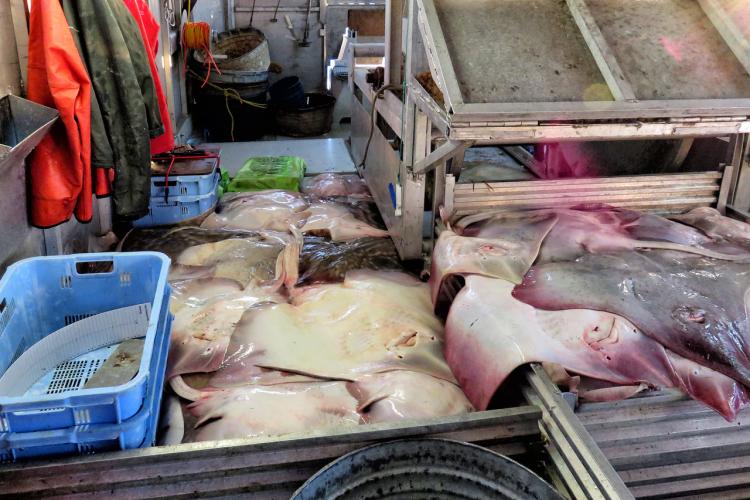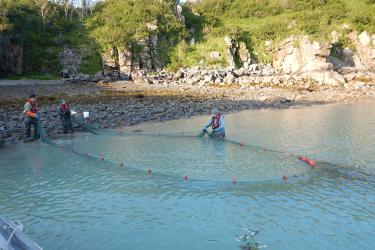
Snap gear fishing vessel.
I was informed by my coordinator to contact the captain of my next vessel as soon as I had collected my gear at the airport; but upon talking with him I was told the weather would delay the start of their trip until the following day. I scheduled a time to come down to the boat and asked about a couple other details. I was happy to hear the boat was delayed because it gave me a chance to take a shower. This is a luxury after traveling on airplanes and especially right before I get on a boat since I never know exactly how long it will be until my next one. One time I flew straight to Sitka after a day of briefing in Seattle and was picked up by the captain of a boat to go directly to the vessel. The crew wanted to leave before midnight because it was bad luck to leave port on a Friday. If I had not made it to the boat late Thursday evening, the vessel would have had to wait a whole other day to depart. The trip ended up lasting 10 days on a 58’ vessel. It’s still my longest stint to date of not showering. I promise you this unhygienic record was not by choice.

Observer collecting an otolith sample.
On Monday, I headed down to the boat at the fuel dock. There were only two crew members, the captain and one deckhand. They had been fishing together for quite some time. Because a weather front was supposed to be hitting the area within the next couple days, I was told this would be a quick trip. We left the dock in the late afternoon. As we exited the protection of the breakwater a swell was already upon us. I had put on a scopolamine patch an hour or two before we left the dock, but alas it was not early enough. Although I did not succumb to sea sickness, I did become very tired all of a sudden. I could tell the captain and deckhand were also feeling the effects of the swell as everyone grew quiet. I popped in my ear buds to try and focus on some good feeling music, which often helps me relax in bad weather.
Only one “tester” string was set so the captain could see what the fishing was like in the area. He would not set any other gear until after the first set was hauled in the morning. While the guys were setting, I had noticed that none of the hooks were baited. They were baiting as the line was going out, removing yet another step that is normally completed before gear is deployed. No wonder they could be so productive with just the two of them!
As we approached our anchor point for the evening, it was clear none of us had much of an appetite for dinner. It was a unanimous vote to skip a meal, but they made sure to tell me where all the goods are stashed in case I became hungry during the night. My bunk was in the forepeak, which I had all to myself! This was the first time I could claim my own room on such a small boat. Both of the crew slept on bunks in the wheelhouse. I woke up to the sound of the anchor chain as it was retrieved on the bow. I carefully poked my head out from my dark, cold sleeping hole into the surprisingly bright wheelhouse. We were making our way back to the gear, and the weather proved to be a good bit better than the evening before.

Pacific cod and observer sampling area.
Unlike “stuck” longline gear, I sample snap gear based on both number of hooks I need to sample and time. Since gear is not segmented, but rather just one long string of gear, I determine a discrete number of hooks I need to sample for each tally session, and then use an approximate retrieval time to estimate when those hooks will be retrieved during the set. Using a stop watch, I can easily keep track of when I need to start sampling. For the first or even second set of gear on snap longliners, it’s not uncommon to under or over estimate this time, but with later hauls you can adjust this time to better reflect total time of retrieval.
After observing for over four years, it is becoming rarer for me to come across new species. My last 70 day deployment resulted in not a single new species! The chore that was once filling out those pesky species identification forms required by the program are now a grand quest of discovery. Many crew are good about showing me something unique or strange if they find something worth sharing (yes, there is an inner-naturalist in all of us), but I have been hard to please recently. So when I finally came across a canary rockfish, I was floored! I wouldn’t say canary rockfish are a super exciting or novel species, and I have seen them before in aquariums, but coming across one on a boat meant making another notch on my list of identified species.
When the first string was completely retrieved, I could sense a little disappointment in the crew. It wasn’t the “best” fishing, perhaps not even “good” fishing, but the deckhand who had been cleaning halibut called out “That was the best set of the year!” His proclamation was true, it was indeed the best set of the year, but it was also the first and only set of the year. We all burst out laughing at his observation. It’s always nice working with good-humored crew.
Another three sets were made, and after a little soak time, they began hauling again. The rest of the sets had actually turned out a little better than the first haul, which put them in a good position to call it quits for the trip. We ended up anchoring again in the evening before continuing back to Sitka, and the boat delivered later that afternoon. They had timed the trip well because as we pulled into the harbor slip, the wind began picking up again.




